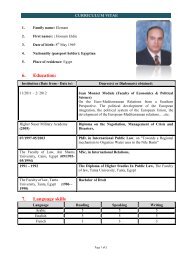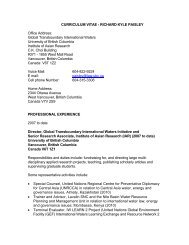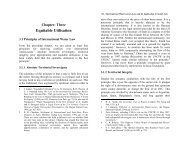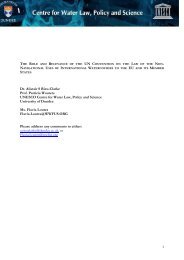Upreti, Trilochan, International Watercourses Law and Its Application ...
Upreti, Trilochan, International Watercourses Law and Its Application ...
Upreti, Trilochan, International Watercourses Law and Its Application ...
You also want an ePaper? Increase the reach of your titles
YUMPU automatically turns print PDFs into web optimized ePapers that Google loves.
64 / <strong>International</strong> <strong>Watercourses</strong> <strong>Law</strong> <strong>and</strong> <strong>Its</strong> <strong>Application</strong> in South Asia Development <strong>and</strong> Codification of <strong>International</strong> <strong>Watercourses</strong> <strong>Law</strong> / 65<strong>and</strong> benefits were equally shared <strong>and</strong> the project undertakenjointly. The Columbia River was regarded as a unit <strong>and</strong>developed along those lines. The concept could be followed inseveral situations including the Indo-Nepal water issues <strong>and</strong>other circumstances as well. In fact, Nepal is always insistingon following the concept envisaged in the above treaty, which,she believes, would provide her the opportunity to have areasonable <strong>and</strong> equitable entitlement to her huge waterresources <strong>and</strong> it is largely advocated that the said treaty couldbe the basis to resolve all outst<strong>and</strong>ing issues with her riparianstates. 119 Both Canada <strong>and</strong> Nepal have huge water resources, itsutilisation requires cooperation from downstream neighbours,USA <strong>and</strong> India, by paying benefits they accrued from the workof upstream countries. This is because in order to maximisebenefits, construction of dams <strong>and</strong> reservoirs in upstreamcountries is essential. That causes inundation of l<strong>and</strong>,resettlement of people, extinction of flora <strong>and</strong> fauna etc, butprovides huge benefits downstream. These include floodbenefits, hydropower, irrigation <strong>and</strong> others. The benefits shouldbe shared mutually. Canada <strong>and</strong> the United States were able tomaximise such benefits by agreeing to share both costs <strong>and</strong>benefits from the work among themselves. The situation overthe Columbia River basin <strong>and</strong> Nepal <strong>and</strong> India’s problem bothoccur because of disputes as to the sharing of downstreambenefits. Such problems can be resolved by adopting thedownstream benefit principle, <strong>and</strong> the national interests of bothupstream <strong>and</strong> downstream states could be accommodated,creating ‘win-win’ situations. The treaty has set up a newdimension on how a relatively weak neighbour was enabled tomake agreement with a powerful nation in which equity <strong>and</strong>fairness were obtained for both.2.7.6 Lesotho-Highl<strong>and</strong> Treaty 1986, Lesotho-SouthAfricaThe creation of the Lesotho Highl<strong>and</strong> Development Authorityunder the Lesotho Government was an undertaking responsiblefor executing the overall provisions of this water transfer treaty.Under the provision, an annual payment of $ 13.6 million ismade by South Africa to Lesotho for transferring the waters tothe former as a royalty over the Lesotho resources. A JointTechnical Commission <strong>and</strong> other commissions have been set upto frame policies <strong>and</strong> implement the provisions of the treaty.Electricity generation of 73.4 MW in 1995 <strong>and</strong> 276 MW up to2001 for Lesotho are the benefits set against the cost incurredby South Africa. Lesotho received WB financing for thosehydroelectric projects. In lieu of the water transfer to South-Africa, she paid money to Lesotho.This treaty, which could be a unique type of sharing of benefitsby transferring waters of an entire river, represents bothinterests <strong>and</strong> benefits. Boadu has said that the concept drawnfrom the 'transaction costs literature' ( “The costs associatedwith the process of buying <strong>and</strong> selling. These are small frictionsin the economic sphere that often explain why the price systemdoes not operate perfectly.” 120 ) was used to analyse thegovernance structure of the trans-boundary water treatybetween the two states. In the context of international treaties,‘transaction costs’ refers to those costs associated withinteractions between nations. These include “information,contracting <strong>and</strong> policing costs (ICP)”. 121 However, theopposition party in South Africa criticised the treaty, calling it‘surrender of sovereignty to a much smaller country’.119 B. G. Verghese, Waters of Hope, New Delhi: Oxford IBH Pub., 1990,p. 345.120 G. Bannock, R. E. Baxter & E. Davis, The Penguin Dictionary ofEconomics, London: Penguin Books, 1992, p. 426.121 F. O. Boadu, "Rational Characteristics of Trans-boundary WaterTreaties: Lesotho Water Transfer Treaty with the Republic of SouthAfrica" (1998) 38 NRJ, pp. 381-403.












